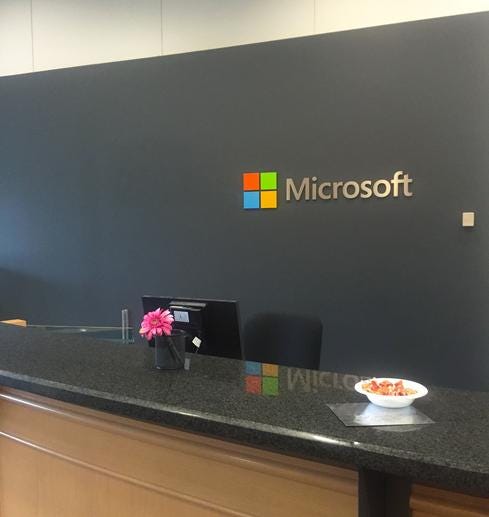Microsoft Azure: More Mature Cloud PlatformMicrosoft Azure: More Mature Cloud Platform
With Azure, Microsoft stakes claim against Amazon and Google, touting its ability to serve as a more muscular cloud partner for the enterprise data center.


Microsoft Insider: 2 Days On Redmond Campus
Microsoft Insider: 2 Days On Redmond Campus (Click image for larger view and slideshow.)
Microsoft unveiled a new type of virtual machine for its Azure cloud and showed off a broader set of cloud services Tuesday, Sept. 29, in a widely viewed virtual event, AzureCon. The combination was meant to showcase Azure as a more muscular partner for the enterprise data center.
In the process, Scott Guthrie, executive VP of Microsoft's Cloud and Enterprise Group, took a more directly combative stance versus Amazon Web Services and the Google App Engine/Compute Engine clouds. Azure is available in 24 regions around the world, including three where it has opened in India -- in the western, central, and southern parts of the country. Microsoft's total of 24 regions represents twice as many as Amazon and five times as many as Google, Guthrie asserted.
"We're unique in being able to offer customers an Azure stack to deploy on-premises" to give them a private cloud environment that's a match to their public cloud environment, he added. The Azure stack means customers have the same management API, the same management portal, and the same experience running Azure servers on-premises as in the cloud.
At the same time, Microsoft has put together an extensive platform-as-a-service development environment that meshes with Microsoft's Visual Studio and SQL Server tools on-premises.
Some startups find Azure's services sufficient by themselves. "SQL Azure, Azure Redis, and Service Bus really accelerated our time to market by 12 to 14 months," said Mike Hanrahan, cofounder and CTO of Jet.com, an online retail shopping startup, during the event. Jet.com turned to Azure to meet its rapid expansion goals -- it's shooting for $20 billion in revenue by 2020. Forty percent of Azure revenue now comes from startups, independent software vendors, and small companies, Guthrie noted.
[Want to learn more about enterprise use of public clouds? See Clouds Ready for Enterprise? Gartner Says Few Are.]
At the same time he didn't hesitate to emphasize how Azure already has a foot in the door at many large enterprises, thanks to Windows Server's strong presences in the data center. "Eighty percent of the Fortune 500 uses the Microsoft Cloud," said Guthrie, and, as if to prove his point, enterprise users Thyssen, NASCAR, Wal-Mart, and Rockwell Automation, along with Azure user the United Nations, were on the virtual event's agenda.
At the same time, the AzureCon virtual event occasionally gave off an air of having been hastily assembled the week before Amazon's sold-out Re:Invent show, to be held in Las Vegas Oct. 6-9. Azure CTO Mark Russinovich's attempted demonstration of Docker container orchestration stalled in its final step.
Enterprise users can turn to Azure for a wide selection of virtual servers. In January, Microsoft launched its G-series of virtual machines. They remain the largest virtual machines available in the public cloud, Guthrie said. The G1 starts out with a two-core CPU, 28 GB of RAM, and 412 GB of solid state disk. The G5 tops out at 32 cores, 448 GB of RAM, and 6.6 TB of SSD.
Enterprise users will have another virtual machine option as well, one that might forestall the purchase of expensive, high-end graphic workstations. Guthrie said Microsoft was adding the N-series virtual machines powered by Nvidia graphic processing units. Nvidia GPUs are frequently used for accelerated graphics and in other compute-intensive tasks.
Microsoft is the first cloud supplier to use Nvidia's Grid 2.0 GPU as a basis for a new cloud virtual machine, Guthrie said. Grid 2.0 was launched Aug. 30 at VMworld, where Nvidia officials said an Nvidia host using the Grid 2.0 could run 128 virtualized users -- twice as many as its predecessor. Researchers, engineers, and graphic designers will be able to use the virtual machines to run complex, data-intensive designs.
Guthrie offered a slate of overall usage figures to persuade his audience that Azure is gaining ground as a big-league provider of compute services. It's gaining 90,000 new subscribers a month, and runs 1.5 million SQL databases, he said. It's now gathering in 1.5 trillion IoT event messages a month and 777 trillion storage transactions a day. Visual Studio Online, the collaborative Azure-based version, has 3.4 million registered developers.
Azure has a total of 500 million Azure Active Directory users, Guthrie said, which would include Dynamics CRM, Skype, and Office 365 users as well as users of cloud virtual machines.
With machine learning playing a prominent role as companies begin to collect data off the Internet of Things, Guthrie and other AzureCon speakers emphasized an Azure service that launched in February: Machine Learning as an Azure cloud service. Machine Learning can work with the SQL Data Warehouse on Azure to query machine or system data, build predictive models based on it, expose the model via an API, and "start being able to take intelligent actions" based on its predictions, said Guthrie.
Monitoring heavy industrial machines, predictive modeling, and preventive or even "pre-emptive" maintenance was one of the possibilities available through the IoT Suite that Microsoft announced as available Tuesday.
Guthrie and other speakers emphasized the capabilities of the new Security Center now inside the Azure Management Portal. By signing up for the service, a customer can get alerts from the Azure security staff that their virtual machines in the cloud are under malware or denial of service attacks. The center can point out where (and maybe who) the attack is coming from and intercept its activity.
The center uses its watchdog software to identify websites that have recently been compromised by malware and guard against any associated threats or attacks that may be directed at Azure customers.
About the Author
You May Also Like






